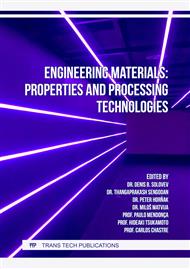[1]
V.E. Kopylov, Mineral powders from local raw materials for the production of asphalt concrete, Materials for technical devices and structures used in the Arctic, Collection of conference documents, FGUP VIAM, Moscow. 2015, p.27.
Google Scholar
[2]
O.N. Burenina, Possibilities of obtaining asphalt concrete pavements of improved quality in a cold climate, New materials and technologies in the Arctic, Proceedings of an international symposium, Northeastern University. M.K. Ammosova, 2014, pp.253-256.
Google Scholar
[3]
GOST 22245-90, Bitumen oil road bonds, Technical conditions, Moscow. IPK Publishing house of standards, 2005, p.9.
Google Scholar
[4]
GOST 11506-73, Petroleum bitumen's, Method for determining the softening point of the ring and ball, Moscow. Standartinform, 2008, p.8.
Google Scholar
[5]
GOST 11507-78, Petroleum bitumen's, Method for determination of brittleness temperature according to Fraas, Moscow. Standartinform, 2008, p.8.
Google Scholar
[6]
P.A. Arutjunov, Parameter system for the analysis of roughness and microrelief of the surface of materials in scanning probe microscopy, Factory laboratory. T. 65, 9(1999) 31-41.
Google Scholar
[7]
A.L. Tolstihina, What an atomic force microscope sees? Nature. 1(1181) (2014) 62-72.
Google Scholar
[8]
I.A. Rybev, Asphalt concrete, Textbook. Manual for construction universities, Moscow., «graduate School», 1969, p.399.
Google Scholar
[9]
N.V. Gorelyshev, Asphalt concrete and other bitumen-mineral materials, Moscow. Terra, 1995, p.176.
Google Scholar
[10]
V.D. Galdina, Mineral powders from oil shale, Science and technology in the road industry. 2 (2015) 20-24.
Google Scholar
[11]
O.A. Bogatikov, Igneous rocks, Moscow. Nauka, T. 1: Classification, nomenclature, petrography. Ch. 2, 1983, p.768.
Google Scholar
[12]
V.E. Kopylov, Mineral raw materials of the Republic of Sakha (Yakutia) for the production of asphalt concrete, Internet magazine «NAUKOVEDENIE». Tom 8, №1, 2016. DOI: 10.15862/47TVN116 http://naukovedenie.ru/PDF/47TVN116.pdf
Google Scholar
[13]
V.E. Kopylov, The use of mineral powders from local raw materials for the production of asphalt concrete in the conditions of the Republic of Sakha (Yakutia), Yakutia Teksch: dis. ... kand. tehn. nauk: 05.23.05, Ulan-Udje., 2016, p.140.
Google Scholar
[14]
J.V. Kotljarskij, Construction and technical properties of road asphalt concrete: textbook. Moscow. MADI (GTU), 2004, p.192.
Google Scholar
[15]
V.D. Galdina, Mineral powders from oil shale, Science and technology in the road industry. 2 (2015) 20-24.
Google Scholar
[16]
S.K. Iliopolov, Organic binders for road construction, Moscow. Jug, 2003, p.428.
Google Scholar
[17]
M.S. Lebedev, Asphalt binders using aluminosilicate raw materials, abstract of Ph.D. dis. for a job. Scientific degree feature 05.23.05 Building materials and products, Belgorod, 2012, p.25.
Google Scholar
[18]
K.A. Bosholov, Asphalt concrete using activated silica-containing mineral powders: dis. ... Candidate of Engineering Sciences: 05.23.05, Ulan-Udje, 2007, p.114.
Google Scholar
[19]
A.V. Vasilev, Infrared Spectroscopy of Organic and Natural Compounds: A Study Guide, SPb: SPbGLTA, 2007, p.54.
Google Scholar
[20]
K. Nakanisi, Infrared spectra and structure of organic compounds, Moscow. Mir, 1965, p.210.
Google Scholar


